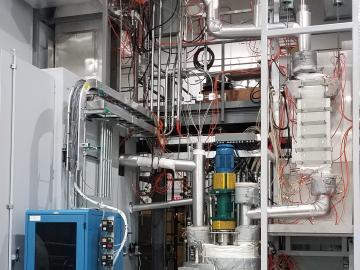Filter News
Area of Research
- Advanced Manufacturing (1)
- Biology and Environment (30)
- Clean Energy (28)
- Computer Science (1)
- Electricity and Smart Grid (1)
- Fuel Cycle Science and Technology (1)
- Fusion and Fission (15)
- Fusion Energy (3)
- Isotopes (11)
- Materials (31)
- National Security (19)
- Neutron Science (18)
- Nuclear Science and Technology (1)
- Supercomputing (44)
News Type
News Topics
- 3-D Printing/Advanced Manufacturing (12)
- Advanced Reactors (2)
- Artificial Intelligence (28)
- Big Data (6)
- Bioenergy (14)
- Biology (23)
- Biomedical (6)
- Biotechnology (3)
- Buildings (11)
- Chemical Sciences (13)
- Clean Water (5)
- Climate Change (22)
- Composites (4)
- Computer Science (19)
- Coronavirus (1)
- Critical Materials (1)
- Cybersecurity (6)
- Decarbonization (26)
- Education (1)
- Emergency (2)
- Energy Storage (9)
- Environment (35)
- Exascale Computing (15)
- Fossil Energy (4)
- Frontier (18)
- Fusion (10)
- Grid (14)
- High-Performance Computing (25)
- Hydropower (2)
- Isotopes (12)
- Machine Learning (14)
- Materials (28)
- Materials Science (15)
- Mathematics (3)
- Mercury (1)
- Microelectronics (2)
- Microscopy (5)
- Nanotechnology (5)
- National Security (22)
- Net Zero (6)
- Neutron Science (24)
- Nuclear Energy (18)
- Partnerships (13)
- Physics (11)
- Polymers (3)
- Quantum Computing (12)
- Quantum Science (13)
- Renewable Energy (1)
- Security (2)
- Simulation (26)
- Software (1)
- Space Exploration (7)
- Summit (11)
- Sustainable Energy (18)
- Transportation (7)
Media Contacts

Ben Thomas recalled the moment he, as a co-op student at ORNL, fell in love with computer programming. “It was like magic.” Almost five decades later, he strives to bring the same feeling to students through education and experience in fields that could benefit nuclear nonproliferation.

For nearly six years, the Majorana Demonstrator quietly listened to the universe. Nearly a mile underground at the Sanford Underground Research Facility, or SURF, in Lead, South Dakota, the experiment collected data that could answer one of the most perplexing questions in physics: Why is the universe filled with something instead of nothing?

A scientific instrument at ORNL could help create a noninvasive cancer treatment derived from a common tropical plant.

Joanna Tannous has found the perfect organism to study to satisfy her deeply curious nature, her skills in biochemistry and genetics, and a drive to create solutions for a better world. The organism is a poorly understood life form that greatly influences its environment and is unique enough to deserve its own biological kingdom: fungi.

Environmental scientists at ORNL have recently expanded collaborations with minority-serving institutions and historically Black colleges and universities across the nation to broaden the experiences and skills of student scientists while bringing fresh insights to the national lab’s missions.

Natural gas furnaces not only heat your home, they also produce a lot of pollution. Even modern high-efficiency condensing furnaces produce significant amounts of corrosive acidic condensation and unhealthy levels of nitrogen oxides

Scientists at ORNL have begun operating a unique system designed to enable a variety of testing to characterize the performance of an advanced heat transfer fluid for renewable energy

With larger, purer shipments on a more frequent basis, Oak Ridge National Laboratory is moving closer to routine production of promethium-147. That’s thanks in part to the application of some specific research performed a decade ago for a completely different project.

When Addis Fuhr was growing up in Bakersfield, California, he enjoyed visiting the mall to gaze at crystals and rocks in the gem store.

Hydrologist Jesús “Chucho” Gomez-Velez is in the right place at the right time with the right tools and colleagues to explain how the smallest processes within river corridors can have a tremendous impact on large-scale ecosystems.




